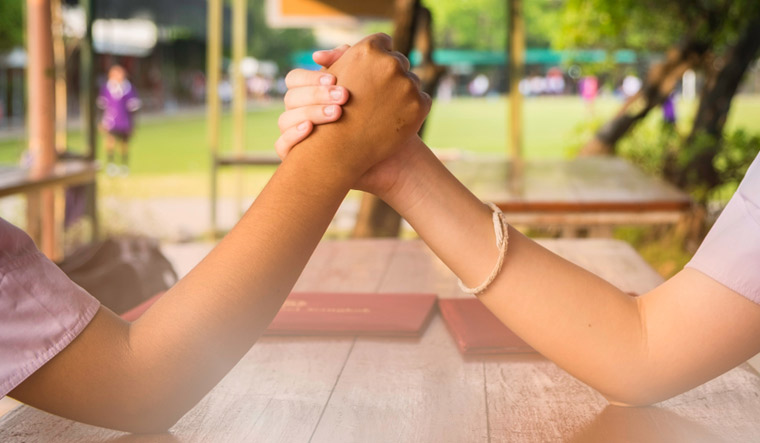As per the 2021 statistics of the National Crime Records Bureau, out of the 5,993 people reported to be trafficked that year, 65 per cent were women. Tthe United Nations Office on Drug and Crime (UNODC), in its global report on human trafficking in 2020, recorded that for every 10 victims recorded globally, five are adult women and two are girls. Faced with such overwhelming statistics, it becomes crucial to examine the reasons that push women to be trafficked.
Even though poverty is one of the major reasons that make women vulnerable to human trafficking, a combination of factors, including prevailing gender and structural inequalities and lack of awareness and illiteracy, contribute to this. Women from poor and economically weaker sections are often exposed to additional complications like lack of access to resources and basic amenities, due to which they are thrust into circumstances of servitude and unemployment, depriving them of their ability to take decisions for themselves.
The female literacy rates in the country have seen a substantial rise in recent years—from 64.64 per cent in 2011 to 70.30 per cent in 2021. However, educationally disadvantaged women lack access to lucrative job opportunities, putting them at risk of being exploited.
Additionally, skewed sex ratio, cultural norms, and gender-based violence make women more vulnerable. The glaring discrimination faced by women, which often results in their exploitation in various spheres, highlights the need to assess the importance of ideas that strengthen their empowerment.
Empowerment is a multidimensional process that enables an individual to regain control over their life. The idea of women empowerment recognises the challenges they face in comparison to their male counterparts. Thus, gender equity becomes an important objective of policies undertaken towards empowering women.
In India, the tales of empowerment of women were first woven through the threads of the fifth five-year plan (1974-79), where the gaze shifted from a strict welfare approach to providing a level playing field to women, boosting their development and equity with men. The National Plan of Action for Women was adopted in 1976. The development initiated in the fifth five-year plan was concertized in the subsequent five-year plan where the planning document included a chapter titled ‘Women and Development’.
The five-year plans have followed the framework laid out in the Constitution of India wherein women hold equal rights and opportunities in political, economic, and social domains. These developments were a precursor to the establishment of the National Commission of Women in 1992.
In a similar vein, aiding female survivors of trafficking in regaining control of their lives can be an essential tool for their reintegration and rehabilitation. Empowerment of female survivors of trafficking can assume many shapes and forms, in the social, educational, economic, political, and psychological areas of their lives.
While social empowerment aims to strike at the rampant prejudice faced by women in society, educational and economic empowerment aims to amplify their prospects of education and financial inclusion. There is a profound need to actively include female survivors of trafficking in the enactment of laws that are structured around their welfare. Provisions of opportunities in the fields of education, occupation and forming of policy will help them recognize their self-worth and gain control over their monetary requirements and physical autonomy.
It is important to create favorable circumstances for women to allow them to exercise their autonomy in leveraging the opportunities that are presented to them.
In the recent past, several such initiatives have been undertaken by the government that lay down the brickwork for the women to chart their own path as per their wishes and areas of interest.
Self-Help Groups (SHGs) have been formed in states like West Bengal and Karnataka under the Swayamsiddha and Stree Shakti schemes, respectively, to impart financial control to women survivors. Programmes have also been implemented by state governments to provide financial relief and training to survivors to enable them to be self-reliant and achieve social and economic empowerment.
Along the same lines, programmes have been designed for the empowerment and rehabilitation of female survivors of trafficking. The Asmi Kendra, in West Bengal, built as safe space for women survivors of human trafficking, ensures their mental well-being, and provides vocational and skill-based training. At the national level, the government introduced the NALSA (Victims of Trafficking and Commercial Sexual Exploitation) Scheme, 2015, to provide legal services to victims of trafficking including women of all age groups. In 2016, the ministry of women and child development launched UJJAWALA, a comprehensive scheme for the prevention of trafficking and rescue, rehabilitation, and re-integration of victims of trafficking for commercial sexual exploitation.
While commendable steps have been taken towards the prevention, protection, and rehabilitation of female trafficking survivors, there is a need for women survivors to rewrite their narratives and pioneer the anti-trafficking movement by addressing the gaps in solution-oriented governance. Platforms such as the Indian Leadership Forum Against Trafficking (ILFAT) have put the female survivor voices at the forefront of the movement against trafficking and helped build a blueprint for tackling the global challenge of trafficking through survivor leadership.
As India excels on a global stage, all sections of society should have access to its riches and successes. Hence, it is imperative for the female survivors of trafficking to forge forward and paint their canvas with the colors of grit, empowerment, and courage.
(The authors are survivor leaders from the Indian Leadership Forum Against Trafficking (ILFAT))



